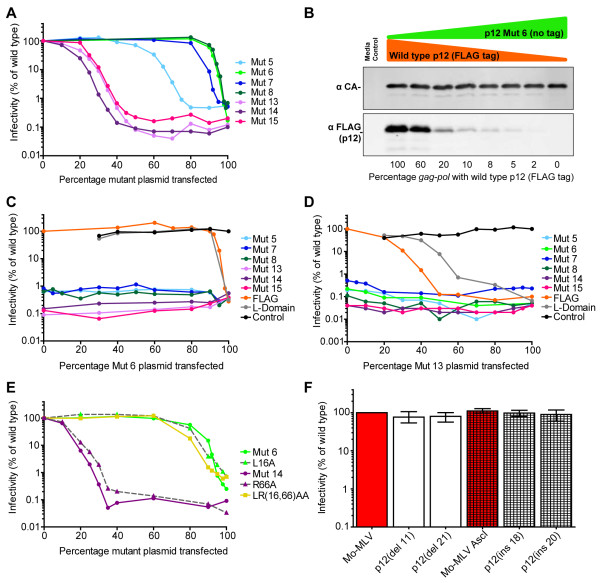Figure 2.
Infectivity of mixed mutant/wild type p12 particles. (A) Mo-MLV LacZ-encoding VLPs containing a mixture of wild type and mutant p12 were synthesized as described in the text. D17 cells were challenged with equal RT-units of VLPs and infectivity was determined by measuring β–galactosidase activity. Infectivity is plotted as a percentage of the infectivity of VLPs with 100% wild type p12. (B) Mixed particles containing various ratios of un-tagged mutant 6 p12 and FLAG-tagged wild type p12 were analyzed by immunoblotting with antibodies against MLV CA (top panel) and FLAG (bottom panel). (C and D) The infectivity of mixed particles containing two different p12 mutants was tested as in (A). Either mutant 6 (C) or mutant 13 (D) were mixed with each other mutant (shown in the key), wild type FLAG-tagged p12 (orange line) or an L-domain mutant (grey line). As a control for mixed particle synthesis, wild type p12 was mixed with an L-domain mutant (black line). For this sample, the percentage of wild type p12 plasmid in the transfection is plotted on the x-axis. (E) Mixed virus particles containing wild type p12 and either mutant 6, mutant 14, L16A, R66A or the double mutant LR(16, 66)AA were produced and analyzed as in (A). All panels are representative of 3 experiments. (F) Deletions of 11 or 21 amino acids (residues D43-P53 and P37-A57 respectively) were created in p12. Additionally, an AscI site was introduced into gag corresponding to residues 49 and 50 in p12 and an alanine cassette (of 18 or 20 amino acids) was inserted. VLPs bearing these alterations were produced and their infectivity tested in D17 cells. The mean and range of three independent experiments are shown.

